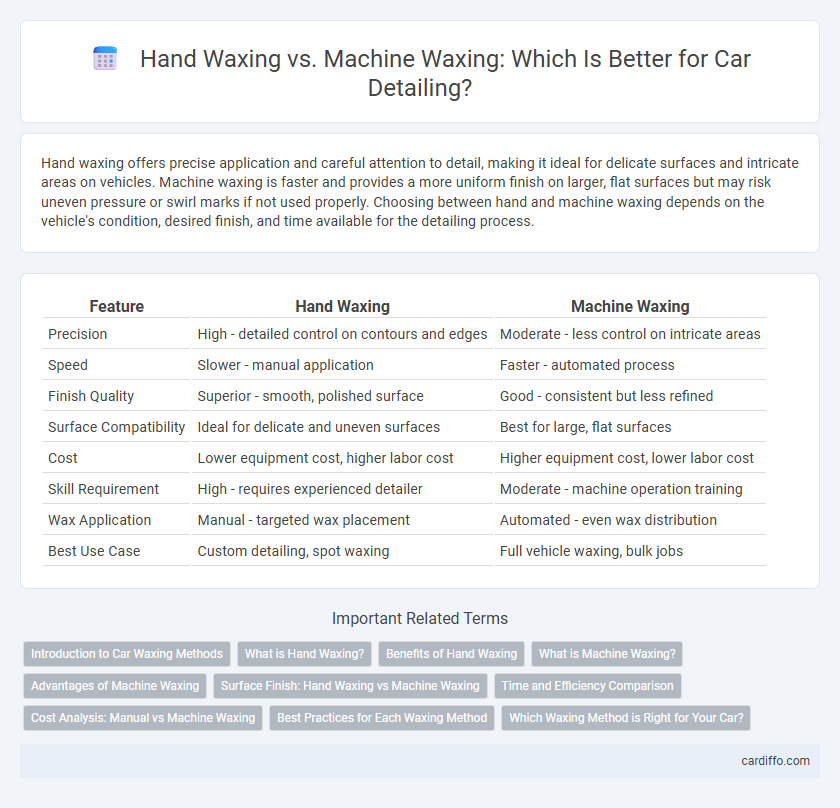Hand waxing offers precise application and careful attention to detail, making it ideal for delicate surfaces and intricate areas on vehicles. Machine waxing is faster and provides a more uniform finish on larger, flat surfaces but may risk uneven pressure or swirl marks if not used properly. Choosing between hand and machine waxing depends on the vehicle's condition, desired finish, and time available for the detailing process.
Table of Comparison
| Feature | Hand Waxing | Machine Waxing |
|---|---|---|
| Precision | High - detailed control on contours and edges | Moderate - less control on intricate areas |
| Speed | Slower - manual application | Faster - automated process |
| Finish Quality | Superior - smooth, polished surface | Good - consistent but less refined |
| Surface Compatibility | Ideal for delicate and uneven surfaces | Best for large, flat surfaces |
| Cost | Lower equipment cost, higher labor cost | Higher equipment cost, lower labor cost |
| Skill Requirement | High - requires experienced detailer | Moderate - machine operation training |
| Wax Application | Manual - targeted wax placement | Automated - even wax distribution |
| Best Use Case | Custom detailing, spot waxing | Full vehicle waxing, bulk jobs |
Introduction to Car Waxing Methods
Car waxing methods primarily include hand waxing and machine waxing, each offering distinct benefits for paint protection and shine enhancement. Hand waxing allows for precise application and control, especially on intricate surfaces, while machine waxing delivers faster coverage and more consistent results on large areas. Selecting the appropriate method depends on factors such as vehicle size, desired finish, and user experience in detailing.
What is Hand Waxing?
Hand waxing involves applying wax manually using a soft cloth or sponge, allowing for precise control and attention to detail on the vehicle's surface. This method helps achieve a deeper bond between the wax and the paint, enhancing protection against UV rays, dirt, and moisture. Hand waxing is ideal for delicate areas and ensures an even, high-quality finish compared to machine waxing.
Benefits of Hand Waxing
Hand waxing provides a more precise and controlled application, allowing for better coverage in intricate areas compared to machine waxing. This method is gentler on the paintwork, reducing the risk of swirl marks and fine scratches while enhancing the depth and gloss of the vehicle's finish. The superior ability of hand waxing to evenly distribute wax ensures longer-lasting protection against environmental contaminants and UV damage.
What is Machine Waxing?
Machine waxing uses a specialized buffer or polishing machine to apply wax evenly and thoroughly on a vehicle's surface, enhancing gloss and protection. This method delivers consistent pressure and speed, allowing deeper penetration and a smoother finish compared to hand waxing. Machine waxing is ideal for larger vehicles or detailed jobs where efficiency and uniformity are priorities.
Advantages of Machine Waxing
Machine waxing offers a more consistent and even application of wax, resulting in a smoother and longer-lasting finish compared to hand waxing. It significantly reduces application time, making it ideal for large surfaces and professional detailing services. The controlled pressure and heat from machine waxing also enhance wax absorption, improving paint protection and shine durability.
Surface Finish: Hand Waxing vs Machine Waxing
Hand waxing delivers a highly controlled application, allowing precise coverage that enhances the surface finish with a rich, even gloss and minimal streaks. Machine waxing uses a motorized buffer that applies consistent pressure and speed, producing a smooth, uniform shine but can risk swirl marks if not used carefully. Surface finish results depend on the skill level and technique, with hand waxing preferred for delicate areas and machine waxing favored for larger surfaces.
Time and Efficiency Comparison
Hand waxing offers precise control for delicate areas but is generally slower, taking approximately 30 to 60 minutes per vehicle. Machine waxing accelerates the process, cutting application time to about 15 to 25 minutes by delivering consistent pressure and even coating. Efficiency gains from machine waxing also reduce labor costs and enable higher throughput in professional detailing shops.
Cost Analysis: Manual vs Machine Waxing
Hand waxing typically costs more due to the skilled labor and time required to ensure precision and avoid damage, averaging $100 to $200 per vehicle. Machine waxing, leveraging automated tools and consistent application, reduces labor hours and expenses, bringing prices down to approximately $50 to $120 per vehicle. The cost efficiency of machine waxing makes it a preferred option for large fleets or frequent detailing, while hand waxing remains favored for premium finishes and customized care.
Best Practices for Each Waxing Method
Hand waxing requires precise temperature control and even application to avoid uneven coverage and skin irritation, making it ideal for delicate or intricate surfaces. Machine waxing ensures consistent pressure and speed, enhancing uniformity and efficiency, especially on larger vehicles or flat panels. Using microfiber applicators for hand waxing and soft foam pads for machines optimizes finish quality and reduces the risk of swirl marks.
Which Waxing Method is Right for Your Car?
Hand waxing provides precise control and a deeper shine, making it ideal for intricate surfaces and older vehicles needing gentle care. Machine waxing covers larger areas quickly with consistent pressure, perfect for newer cars or when time efficiency is a priority. Evaluating your car's paint condition and your desired finish helps determine if hand waxing's meticulous approach or machine waxing's speed better suits your detailing needs.
Hand Waxing vs Machine Waxing Infographic

 cardiffo.com
cardiffo.com